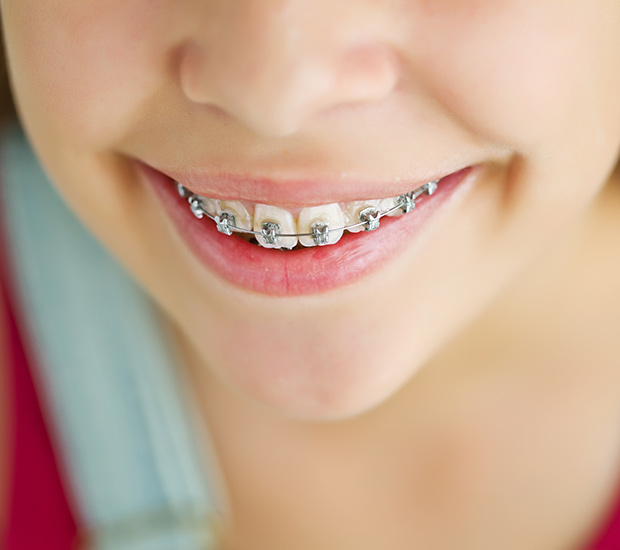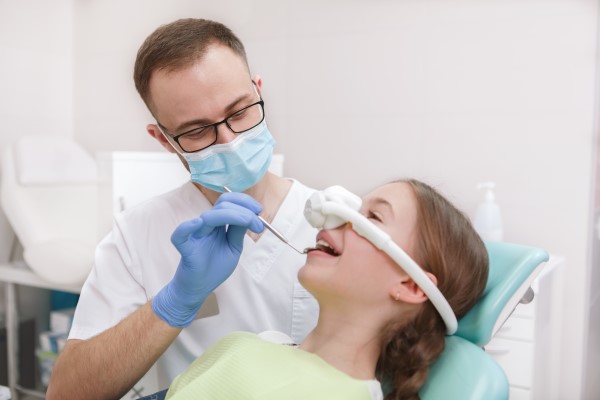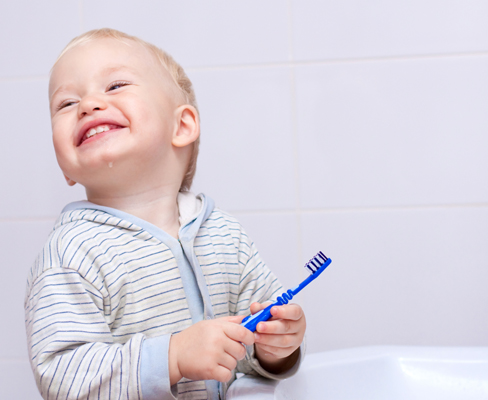Orthodontics for KidsGainesville, VA
It is not uncommon to be told a child needs to see an orthodontist for an evaluation. Orthodontics for kids can treat many problems ranging from crowded or overlapping teeth to issues with jaw growth. These problems can be caused by tooth decay, an early loss of baby teeth, genetics, or habits like pacifier use or thumb sucking.
A visit to a pediatric orthodontist can potentially identify areas of concern before there are any noticeable signs. Orthodontics for kids is available at River Vale Orthodontics in River Vale and the surrounding area. Call us at (703) 651-1566 to schedule a consultation for a child.
Understanding Orthodontics for Kids
Even if a child’s teeth appear to be straight, there can be other problems that are not immediately obvious. Orthodontics for kids is designed to evaluate a child’s tooth alignment, bite, and jaw growth and alignment. If a problem is recognized early, treatment can start right away, potentially eliminating the need for costly procedures later. A follow-up visit is normally scheduled for a year or two later if the pediatric orthodontist does not see any immediate concerns.
Orthodontics for kids is approached a bit differently than orthodontics for teens and adults. A child’s orthodontic appliance will often guide jaw growth and tooth development, creating a better space for adult teeth to come in. Orthodontics for teens is typically done when all the permanent teeth have emerged. Adult orthodontic treatment presents an entirely different set of challenges and may require more extensive procedures to be successful.
Even if a child’s teeth appear to be straight, there can be other problems that are not immediately obvious.
When Orthodontics for Kids Is Necessary
Orthodontics for kids becomes necessary when there are issues with tooth alignment and jaw growth. This can include an overbite or underbite. An overbite is when the upper teeth protrude beyond the lower teeth, and an underbite is when the lower teeth protrude beyond the upper teeth. Either condition can be caused by a problem with the growth of the child’s teeth or jaws.
Gaps between permanent teeth or overcrowding can also require early orthodontic treatment. Permanent teeth can be growing crooked or even be missing altogether. Overcrowding of the adult teeth may lead to dental health issues if not corrected early.
It is recommended that children have their first orthodontic evaluation by the age of seven. This does not necessarily mean any treatment will need to start right away. A pediatric orthodontist will do an evaluation and determine when treatment should begin.
Orthodontics for kids becomes necessary when there are issues with tooth alignment and jaw growth.
Benefits of Orthodontics for Kids
Early orthodontic treatment aims to create a healthy and functional bite, which is the result of proper tooth alignment and jaw positioning. When the jaw and teeth line up correctly, overall oral health improves as well as general physical health. Early orthodontic treatment can often be less painful and less time-consuming overall.
Other benefits of early orthodontic treatment include:
- Addressing issues with crooked and overcrowded teeth.
- Addressing gaps between permanent teeth
- Correcting habits such as thumb sucking and tongue thrusting
- Guiding jaw growth
- Helping permanent teeth come in straight
- Preventing more serious dental issues in the future
- Preventing teeth from shifting
Fixing these problems early can also help improve a child’s speech patterns and their ability to bite and chew food properly. It will also familiarize them with the orthodontic process in case they need further treatment when they are older. There is also the cosmetic benefit of a better-looking smile.
Lorem
“The goal of early orthodontic treatment is to create a healthy and functional bite, which is the result of proper tooth alignment and jaw positioning.”
The First Orthodontic Evaluation
X-rays and photos will be taken of the child’s mouth and teeth during the first orthodontic evaluation. This will show the pediatric orthodontist where the teeth are positioned and the location of the permanent teeth that have not erupted yet. The orthodontist will do a full examination of the teeth, mouth, and jaws, ask the child to open wide and bite down and find out whether there have been any problems chewing or swallowing.
A pediatric orthodontist and their staff will work to make the child and parent comfortable during the exam. This can include a comfortable dental chair for the child and bright and colorful artwork in the exam room. Our staff will walk the child and parent through the entire exam process and answer any questions or concerns.
“During the first orthodontic evaluation, X-rays and photos will be taken of the child’s mouth and teeth.”
Questions Answered on This Page
Q. What is orthodontics for kids?
Q. When should children have their first orthodontic evaluation?
Q. What are the benefits of orthodontics for kids?
Q. What will happen during the first orthodontic evaluation?
Q. What are the various types of orthodontic devices for kids?
=Types of Orthodontic Devices
Several orthodontic appliances are commonly used to treat kids. Braces remain the primary way to straighten teeth and correct bite alignment in children. Braces for kids apply pressure to the teeth and jaws to move the teeth into the desired position. Rubber bands are another option when more force is needed to move the teeth and jaws.
Headgear treats patients who have an overbite or underbite. This type of appliance gently pulls on the teeth to restrict further forward growth. A palate expander works to widen the upper jaw by putting slight pressure on the upper molars during each adjustment. An expander helps to create more space for permanent teeth to come in properly.
Space maintainers are designed to keep teeth from drifting into a space left by a prematurely lost tooth. There are also appliances designed to help address thumb sucking and tongue thrusting. Retainers keep the teeth in place once the desired result has been achieved.
There are several orthodontic appliances that are commonly used to treat kids.
Frequently Asked Questions
Q. What orthodontic treatments are common with kids?
A. Kids often struggle with overcrowding caused by losing baby teeth too early or having a palate that is too small. Space maintainers and expanders can help with these problems. It is also not uncommon for a kid to have to wear braces for a little while to bring their teeth into proper alignment.
Q. How long will my child need orthodontic treatment?
A. Length of treatment time will vary from child to child. The average treatment time runs around 22 months. Getting the proper jaw and tooth alignment takes time to complete successfully.
Q. Does my child have to get metal braces?
A. Braces are typically the easiest to care for with younger children. However, there are other options, such as clear aligners or ceramic braces. Our staff will discuss the options and help determine which one is right for your child.
Q. How much does orthodontics for kids cost?
A. Costs depend on the type of treatment being done. It is a good idea to consult with your dental insurance to determine your out-of-pocket expenses. Our staff will be able to help with the process.
Q. Should my child continue seeing the regular dentist?
A. Your child should continue seeing the regular dentist for check-ups and cleanings. These visits are even more important when an orthodontic device is in place. Good oral hygiene will make it easier for orthodontic treatment to be successful.
Definition of Orthodontic Terminology
- Baby teeth
- A set of temporary teeth in children that fall out as the permanent teeth erupt.
- Braces
- A type of fixed orthodontic device used to straighten the teeth.
- Orthodontic appliance
- A fixed or removable dental device that applies force to the teeth and their supporting structures to produce changes.
- Orthodontics
- The specialty field of dentistry dedicated to preventing, diagnosing, and treating irregularities in the teeth and jaws.
- Orthodontist
- A dental specialist qualified in treating irregularities in the teeth and jaws.
- Overbite
- A type of malocclusion where the upper teeth protrude beyond the lower teeth.
- Pediatric orthodontist
- An orthodontist who solely treats children.
- Permanent teeth
- The second set of teeth that follows the baby teeth.
- Underbite
- A type of malocclusion where the lower teeth protrude beyond the upper teeth.
- X-ray
- An image of an internal composition of a part of the body.






